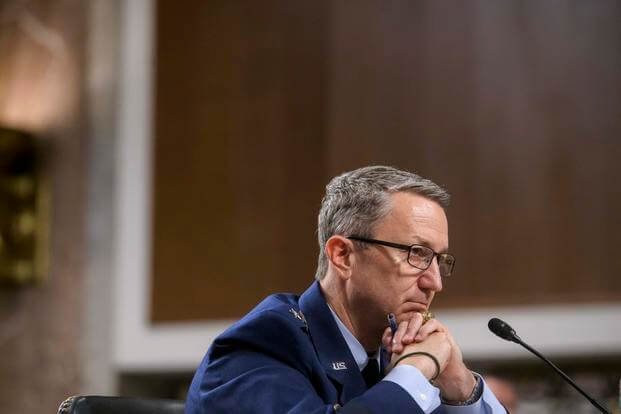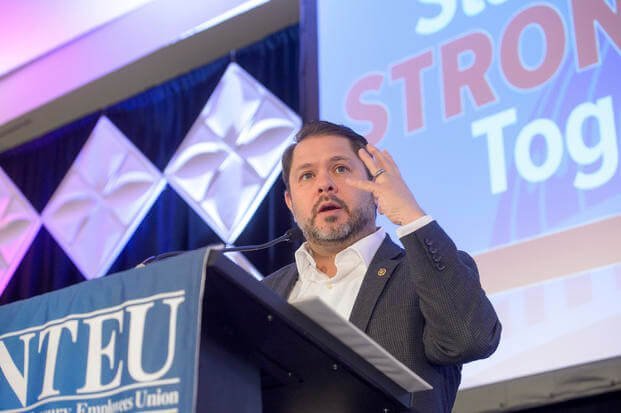
Jennifer Barnhill is a columnist for Military.com writing about military families.
In January 2020, the U.S. Army and Navy banned the Chinese-owned TikTok app on government devices after the Defense Department labeled it a security risk. The ban has since been extended to all branches of service and includes DoD contractors. But despite this legitimate security threat, is TikTok still the military’s best recruiting tool?
“In 2023, veteran-related content on TikTok amassed over 15 billion views, right? That’s with a ‘B,’ 15 billion views,” said Albert Calamug, a Marine Corps veteran who works U.S. Public Policy at TikTok, during a presentation at the Military Influencer Conference (MIC). MIC is an annual event that brings together the people and organizations that promote and support the military community. Notably, TikTok was the only social media platform in attendance despite its tenuous relationship with the Department of Defense.
New military influencers are popping up daily talking about military life — the good, the bad and the ugly. This method of information-sharing holds the potential to give the American public insight into military life that doesn’t require them to pick up a history book or read military news articles. This medium will have an impact on both recruitment and internal top-down and bottom-up communications. But adopting newish platforms and strategies is difficult for any organization to embrace, let alone the military, an institution that fiercely protects its public relations messages.
Read Next: Trump Reportedly Weighs Immediate Discharge of All Transgender Troops. Here’s What That Would Mean.
“The military as a whole really needs to lean into social media because it is where marketing is,” said Johnny Vargas, an active-duty soldier and social media influencer known as Viva La Vargas on TikTok. Despite being strongly encouraged to abandon TikTok in favor of other platforms, Vargas has remained with the app and says his audience wants more military-focused content. Vargas started off by posting summaries of Military.com news stories, information about accessing benefits and skits. “The platform that has given me the most success is Tiktok. … They’ve given me the ability to organically reach so many people, and until I’m faced with, like, a jail sentence or something, I’m still going to use the platform.”
Vargas relies on news sources like Military.com as well as DoD Instructions to ensure his content is both entertaining and accurate. This has resulted in him becoming an accidental recruiter, despite that not being part of his official duties.
“I’m floored and humbled when I get messages and comments of people saying, ‘You know, I reenlisted because of one of your videos,'” shared Vargas. “I’ve also gotten comments of, ‘I’m glad that you’ve told the truth about the military, and now I’ve learned that it’s not for me,’ and that’s OK too.”
Vargas considers himself a “pseudo recruiter,” an unofficial duty he takes very seriously. He said that his command has voiced concerns, but overall supports his work.
While not all influencers feel comfortable using the Chinese-owned platform, most of them, like Vargas, are worried about what they are allowed to do or say online.
Erin Williams, who is an active-duty Army officer and part of a dual-military couple, started out by creating parenting-focused content while on maternity leave following the birth of her first child. Williams, known online as “runstrongmama,” says that all changed after she began teaching at West Point and her cadets found her on Instagram. She realized there was an appetite for information-based content — content that was once shared through face-to-face mentorship. So she began posting more about her experience as a female service member, interpreting Department of Defense Instruction updates and sharing resources she found useful.
“It was something I was hesitant to do for a while,” said Williams. “The military and the DOD has so many different systems and regulations, and it’s so hard to interpret everything. I was maybe a little scared to get something wrong.”
She opted to avoid using the more controversial TikTok and leaned into content she was familiar with — her experience as part of a dual-military couple. This targeted focus has also garnered her the support of her command. But despite having that support, Williams wishes there were more explicit instructions for her content creation.
In October, the Army issued guidance that put the governance of social media and influencer policies in the hands of commanding officers. While giving this additional authority to installation-based leaders provides them with the flexibility and authority to act on a case-by-case basis, it means that the way the Army governs social media will vary. Influencers will have to guess as to what is appropriate and what isn’t. Williams says she wishes the DoD would provide additional higher-level guidance for influencers that goes beyond operational security reminders and how to avoid misrepresenting the military.
Some leaders have attempted to do just that.
“[Influencers] are only able to influence their audiences based on the information or the knowledge that they have,” shared retired Chief Master Sergeant of the Air Force JoAnne S. Bass in a November interview. During her tenure as the most senior enlisted leader of the Air Force, Bass set out to leverage social media to engage with airmen as a method of communication and data collection. She and her team tried to establish ground rules for the medium.
“Service members understand respect on duty and off duty,” said Bass. Although social media is seen as a form of personal expression, military service has different expectations for service members. They have to operate with the same moral compass at work and at home.
“When I got in the seat in 2020, it was clear to me that our service members did not fully understand respect online versus offline, and so this was an opportunity for us as a military to start to own that space,” Bass said.
The Air Force sought to address online behavior as an extension of its social media policy. But there is still a lot about the way that public affairs offices interact with social media influencers that has yet to be outlined in policy.
Military.com reached out to all military branches regarding their social media and “influencer” policies and heard from the Navy and Air Force. Navy officials shared that they updated guidance via a handbook in October aimed at helping public affairs officers navigate this new world of service members acting as a method of communication in their toolbox. The Air Force’s response highlighted its Ambassador program, which seeks to add influencers to its messaging. It is clear that the military is looking to modernize how it communicates with both service members and the American public.
But despite these updates, both the DoD and influencers still have concerns. One is a lack of control of the public narrative. If off-duty personnel are talking about what it is like to serve in the military, their message may not be official, but that may not be clear to the civilian who watches.
Another concern expressed by influencers is a lack of clarity and transparency about monetization.
“I don’t believe that DoD is ready for active-duty influencers to monetize,” said Theresa Carpenter, a Navy public affairs officer and off-duty host of her own podcast S.O.S. (Stories of Service). “There’s no program for it. There’s no permissions for it. And what it is, it’s basically the Wild Wild West right now.”
And if someone who works in public affairs is unclear on how to abide by rules, it is likely other service members feel similarly.
There are instructions that govern social media (DoD Instruction 5400.17) that aim to ensure that all military personnel adhere to ethical practices online and do not compromise the DoD’s reputation. While troops can maintain personal accounts, profiting from content related to their service risks disciplinary actions if it implies endorsement or monetizes the military’s image.
“I’ve chosen to scale [monetization] back, because I don’t want to give anyone the impression I’m making money due to my military affiliation,” shared Williams. “I know it’s, like, a raw point for a lot of soldiers in this space though. … They’re, like, ‘Well, why can’t I show that I’m a soldier working hard, and I use the supplement anyway, so why can’t I get a small commission when somebody uses my link?'”
Just because some influencers are unsure how to navigate monetization of their content doesn’t mean that all are not receiving compensation. Multiple active-duty influencers who asked to remain anonymous said that they believe the military picks and chooses whom it cracks down on based on who toes the line and avoids more difficult conversations.
They also point to the high salaries collected by senior military officials and retirees who are asked to serve on boards of high-profile organizations after service, sometimes earning six- or seven-figure salaries. While this monetization of service is approved and an open path for senior leaders, there are more limited paths for junior personnel.
The perception is tough for some influencers to swallow: You can’t use your military service for profit, but we can.
Related: The Rise of Soldier-Influencers: Army Eyes Policy for Troops with Millions of Online Followers



















